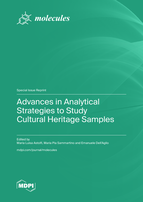Advances in Analytical Strategies to Study Cultural Heritage Samples
A special issue of Molecules (ISSN 1420-3049). This special issue belongs to the section "Analytical Chemistry".
Deadline for manuscript submissions: closed (30 April 2023) | Viewed by 41384
Special Issue Editors
Interests: analytical and bioanalytical chemistry; environmental chemistry and monitoring; elemental analysis; atomic spectroscopic techniques (ICP-MS, ICP-OES, CV-AFS, AMA, GF-AAS); sample treatment; determination of trace elements in foods
Special Issues, Collections and Topics in MDPI journals
Interests: stones; metals; painting; modelling of degradation; microclimate; sensors; biosensors; organic phase enzime electrodes
Special Issues, Collections and Topics in MDPI journals
Special Issue Information
Dear Colleagues,
This Special Issue highlights the most recent advancements and trends in cultural heritage samples' analysis, including archeological and bio-archeological samples.
Cultural heritage samples are complex matrices that are made up of many chemical species of natural origin or due to transformation by humans or the environment. Analytical chemistry in the recent past also required samples of excessive size, and its methods were not sufficiently sensitive. Today, on the other hand, it is possible to optimize analytical methods that are capable of analyzing ever-smaller samples and analytes at ever-lower concentrations. The chemical investigation can help to ascertain the processing techniques and the destinations and uses of archaeological objects, including all human interests and activities (food, art, worship, ornament, use herbal medicines, or drug remedies). Furthermore, the study of organic remains from archaeological sites addresses questions about evolution, past human activities, subsistence, health, medical and care practices, nutrition, and how humans have interacted with or modified their natural environments. In addition, knowledge of the materials used in works of art allows for implementing preventive measures for their optimal conservation and protection. Finally, the analysis of the materials and microelements in the cultural heritage samples can make it possible to establish the geographical origin and authenticity of the find. We invite our colleagues to submit their original contributions as research articles, review articles, as well as short communications, to this Special Issue in order to provide recent updates regarding analytical strategies for all of the above-mentioned aspects.
Dr. Maria Luisa Astolfi
Guest Editor
Dr. Maria Pia Sammartino
Dr. Emanuele Dell'Aglio
Co-Guest Editors
Manuscript Submission Information
Manuscripts should be submitted online at www.mdpi.com by registering and logging in to this website. Once you are registered, click here to go to the submission form. Manuscripts can be submitted until the deadline. All submissions that pass pre-check are peer-reviewed. Accepted papers will be published continuously in the journal (as soon as accepted) and will be listed together on the special issue website. Research articles, review articles as well as short communications are invited. For planned papers, a title and short abstract (about 100 words) can be sent to the Editorial Office for announcement on this website.
Submitted manuscripts should not have been published previously, nor be under consideration for publication elsewhere (except conference proceedings papers). All manuscripts are thoroughly refereed through a single-blind peer-review process. A guide for authors and other relevant information for submission of manuscripts is available on the Instructions for Authors page. Molecules is an international peer-reviewed open access semimonthly journal published by MDPI.
Please visit the Instructions for Authors page before submitting a manuscript. The Article Processing Charge (APC) for publication in this open access journal is 2700 CHF (Swiss Francs). Submitted papers should be well formatted and use good English. Authors may use MDPI's English editing service prior to publication or during author revisions.
Keywords
- Sample preparation
- Toxic metals
- Trace elements
- Multi-element analysis
- Spectrometric techniques
- Organic compounds
- Authenticity
- Chemical fingerprinting
- Biological remains
- Pigments









